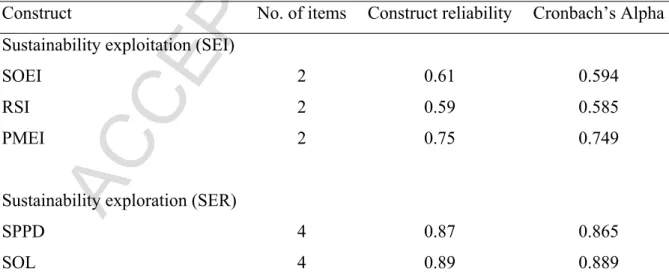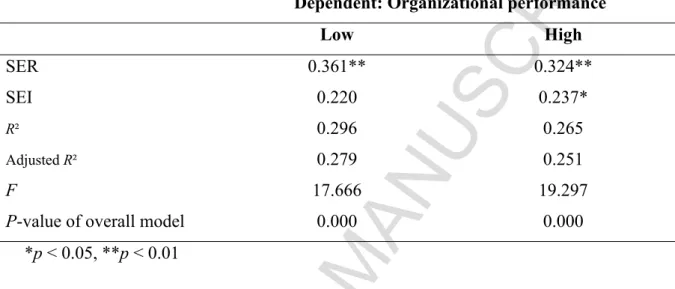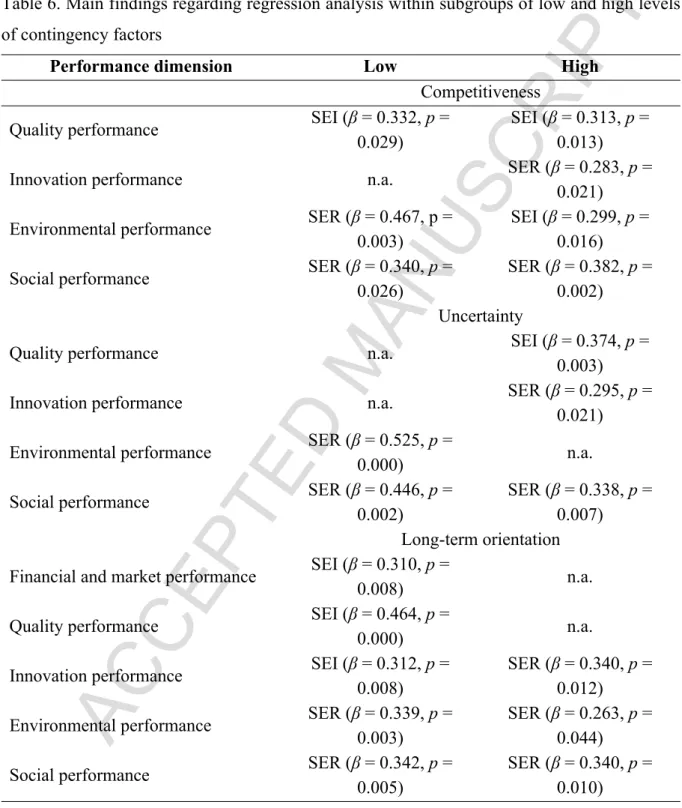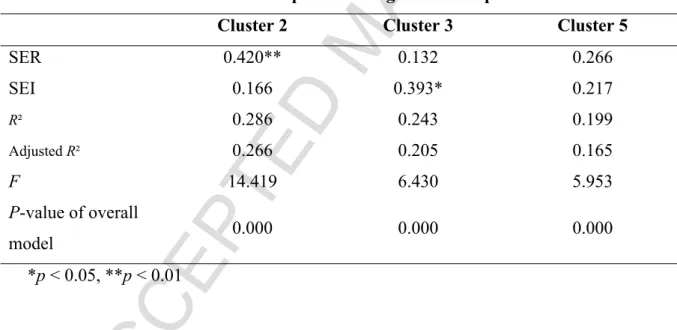The results support the contingency view of the relationship between sustainability practices and organizational performance. This study aims to clarify the understanding of the role of the contingency factors (i.e. long-term orientation, competitiveness and uncertainty) in the relationship between sustainability practices (sustainability exploitation and sustainability exploration) and organizational performance. Accordingly, this paper is based on the work of Maletič et al. 2014) who conceptualized the sustainability exploitation (SEI) and sustainability exploration (SER) practices.
The existing literature, although sparse, clearly points to the possibility that sustainable practices are context dependent (Campbell, 2007; Maletič et al., 2014). Recently, the literature has brought to the fore the concept of innovation related to sustainability (e.g. Lopez-Valeiras et al., 2015) and its connection with organizational performance (Maletič et al., 2016). However, previous studies on corporate sustainability have only used control variables such as industry type and firm size as moderating variables to explain the relationship between sustainability-related practices and financial performance (e.g. Fauzi et al., 2007). .
Uncertainty can also be defined with reference to technological change and environmental instability or unpredictability (Tegarden et al., 2005). Previous studies (e.g. Chen et al., 2014) have suggested that organizations should integrate green exploration and exploitation practices into their long-term strategies to improve their innovation performance. It is assumed that organizations can react proactively to pressure exerted by internal or external stakeholders (Bossle et al., 2016).
In addition, long-term orientation was measured using four items developed during literature review (e.g., Johnson et al., 2012).
Results and analysis
The results show four factors with eigenvalues greater than one, accounting for 70.7% of the variance (K-M-O statistic 0.813; As such, we used Harman's single-factor test by performing exploratory factor analysis on all the measured variables and examined the uro-rotated main factor The following results (Table 3) show the regression results for the two subgroups: low competitiveness and high competitiveness.
Furthermore, the regression analysis was also used to perform subgroup analysis in the context of low and high uncertainty. Results of regression analysis within subgroups of low and high level of long-term orientation. Furthermore, several regression analyzes were used to gain insight into the relationship between sustainability practices and organizational performance dimensions, depending on different levels of contingency factors.
Main findings regarding regression analysis within subgroups of low and high levels of contingency factors. In terms of social performance, SER practices are the most significant contributor at low and high levels within all preparedness factors examined. This analysis was used to derive a typology of the organizations in terms of the level of competitiveness and uncertainty.
The identification of the variables that are included in the analysis is considered as the first step. For this purpose we applied Ward's hierarchical method using Euclidean distance and a clustering plan to determine the number of clusters to be used in a second non-hierarchical K-means analysis that provides the final categorization of organizations. Clustering coefficients increased significantly from groups 6 to 5, from group 5 to 4, from group 4 to 3 and from group 3 to 2, which in terms of the percentage change in the clustering coefficient, lead us to determine that the number the correct groupings are five.
In addition, the ANOVA test was applied to examine differences in SER and SEI due to differences in competitiveness and uncertainty contexts. The environments with a high level of competitiveness and uncertainty (cluster 5) lead to the highest average values in SER (3.88) and a similar average value in SEI (4.02). The results show that SEI appears to be the most important predictor of organizational performance in moderate environmental contexts (β = 0.393, p = 0.046).
In contrast, it appears that as competitiveness increases, SER becomes positively and significantly related to organizational performance (β = 0.420, p = 0.01). The regression model for low levels of competitiveness and uncertainty was not considered due to the small sample size.
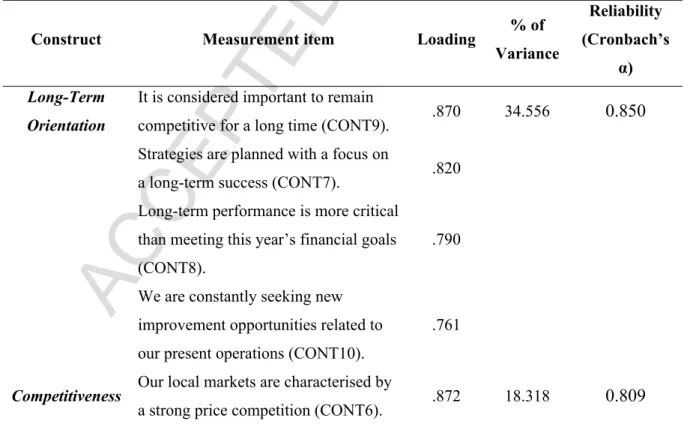
Discussion
The results show that the impact of SER practices on organizational performance is stronger in a less competitive environment (supports H1a). Considering the organization's performance as a composite score, the results show that both SER and SEI are positive and significant within the high competitiveness subgroup. Contrary to our straightforward prediction that organizations would pursue a strategy of greater exploitation in the presence of low uncertainty (H2a), our model determined that SER was the most important variable in predicting organizational performance in the case of low uncertainty .
Furthermore, the results indicate that both types of practices, SER and SEI, appear to be beneficial in influencing organizational performance when environmental uncertainty is high (supporting H2b). The results also revealed that SER affects organizational performance to a stronger degree when organizations strive for long-term prosperity (supporting H3b). According to these findings, sustainability exploitation practices dominate in predicting organizational performance when an organization faces moderate levels of competitiveness and uncertainty.
It appears that when the level of competitiveness is strengthened, sustainability exploration practices affect organizational performance more than sustainability exploitation practices. This study makes a contribution to the literature on corporate sustainability performance (e.g. Wagner, 2010 ) by focusing on the relationship between sustainability exploitation and sustainability exploration practices and organizational performance. Although previous literature has discussed the relationship between sustainability practices and financial performance (e.g. Schrettle et al., 2014), this study further examines the importance of contingencies in the relationship between sustainability practices and broader organizational performance dimensions.
As such, relatively few studies have examined the relationship between sustainability practices and overall organizational performance. Therefore, the overall organizational performance dimensions, which reflect the sustainability benefits of companies with respect to financial and market performance, quality performance, innovation performance, environmental performance and social performance, are also validated and supported by the research framework proposed in this study. Overall, the results support, rather than rely on, the contingency view of the relationship between sustainability practices and organizational performance.
Therefore, the results obtained in this study contribute with knowledge to fill the gap in the line of recent research dedicated to the perspective of contingency in relation to sustainability issues (e.g. Sancha et al., 2016). In our study it is suggested that RVV and SEI practices play an important role in increasing organizational performance. The results confirm the positive relationship between sustainability exploration and sustainability exploitation practices and organizational performance.
Conclusion
Furthermore, organizations that are committed to renewing their business models with sustainability in mind must consider the perspective of contingency as they shape the organization's value proposition and creation. In particular, business model innovation is conceptualized as a fundamental rethinking of the organization's value proposition regarding new opportunities (Bock et al., 2012). However, as research on integrating the notions of exploitation and exploration into the corporate sustainability framework continues to develop, it will become necessary to address inconsistencies regarding the definition of corporate sustainability.
These inconsistencies may hinder the further development of corporate sustainability measures and may cause variations among researchers in their preferred conceptualization and operationalization of sustainability constructs. Second, we recommend that future research develop an in-depth understanding of the mechanisms of how to achieve balance between sustainability exploitation and sustainability exploration practices. In this regard, longitudinal studies could more precisely investigate how sustainability exploitation and sustainability exploration evolve and/or even co-evolve with respect to organizational ambidexterity over time and the impact such patterns have on organizational performance (i.e., short- and long-term performance). ).
SPPD1: The organization implements improvements to radically reduce the environmental impacts of the life cycles of products and services. SOL1: The organization continually enhances the knowledge and skills of employees to improve the effectiveness of current sustainability practices. SOL3: The organization builds on the current knowledge and skills of employees based on examples of CSR best practices.
SOEI2: The organization continuously evaluates its external environment to uncover issues of importance to key stakeholders (customers, suppliers, local communities). RSI2: The organization engages key market stakeholders (customers, suppliers) early in the product/service design and development stage. PMEI2: We have established key performance indicators (KPIs) to determine whether the organization is achieving sustainability goals.
PERF9: The organization has introduced more innovative products and services than our main competitors over the past 3 years. PERF10: The number of innovations that give the organization a sustainable competitive advantage has increased over the last 3 years. Corporate sustainability: an integrative definition and framework for evaluating business practices and guiding academic research.
Beyond limited instrumentality in current corporate sustainability research: Toward a comprehensive notion of profitability. The impact of sustainability exploration and sustainability exploitation practices on organizational performance: a cross-country comparison.
